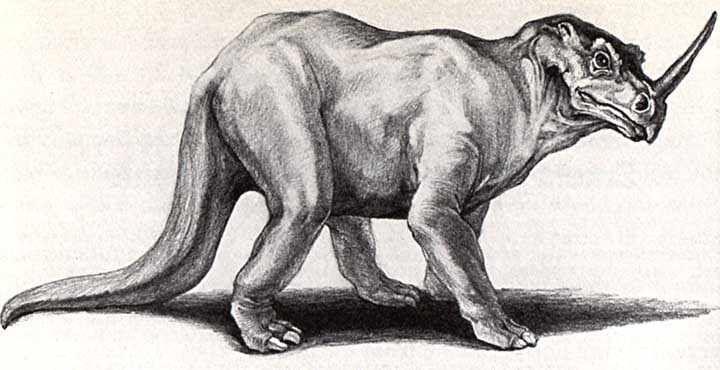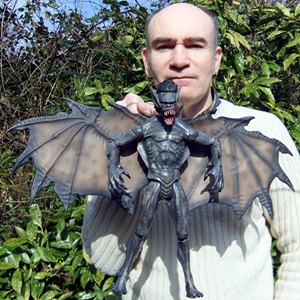The Emela-Ntouka – New Evidence for the Congo’s ‘Killer of Elephants’
Posted by: Karl Shuker on July 11th, 2014
It may be the most famous one, but the long-necked moekel-mbembe, often likened to a sauropod dinosaur, is not the only mystery beast allegedly inhabiting the vast Likouala swamplands of the People’s Republic of the Congo. Less familiar but definitely no less interesting is a second major mystery beast claimed by this region’s pygmies to live here – a truly extraordinary (and exceedingly formidable) creature known to them as the emela-ntouka, or ‘killer of elephants’. The size of an elephant itself, but semi-aquatic, the emela-ntouka is said to have a long heavy tail, four sturdy legs, and, most notable of all, a very long, sharp horn borne upon its snout. On first sight, this cryptid sounds like some form of rhinoceros. However, its long heavy tail differs dramatically from the short, lightweight version possessed by all known rhino species. So too does its horn, for whereas those of rhinoceroses are nothing more than masses of compressed hair, according to native testimony the emela-ntouka’s is said to resemble the ivory tusk of an elephant. As ivory is only associated with tusks and teeth, not horns, however, it is probable that if the pygmies’ claim about it is correct, the emela-ntouka’s horn is composed of bone. Its behaviour is also very distinctive. Although wholly herbivorous, the emela-ntouka is claimed to be extremely belligerent, so much so that if even something as mighty as an elephant or buffalo enters a lake in which one of these creatures is residing, the latter will not hesitate to attack the intruder – stabbing and disembowelling its hapless victim with its formidable snout-horn.

((c) David Miller/Prof. Roy P. Mackal
Moreover, reports of creatures resembling the emela-ntouka are not confined to the Congo. The Democratic Republic of Congo (formerly Zaire) also has its own counterpart, dubbed the irizima, and there are even reports from as far west as Liberia. Moreover, several notable East African lakes, including Lakes Bangweulu, Mweru, and Tanganyika, as well as the Kafue swamps, are said to be inhabited by a very comparable cryptid known as the chipekwe, which kills hippopotamuses with its horn, but does eat them. In 2005, while visiting various remote villages in Cameroon, French field cryptozoologist Michel Ballot came upon, in widely separated villages, two large wooden carvings of horned, heavy-tailed cryptids said to be the emela-ntouka. Now, I can exclusively reveal a third, wholly independent example of artwork from Africa depicting this mystery beast, originating outside Cameroon, but corresponding exactly in its depiction of the latter cryptid, thereby providing exciting corroborative evidence for its reality.
Further details can be found here on my ShukerNature blog.
About Karl Shuker
My name is Dr Karl P.N. Shuker. I am a zoologist (BSc & PhD), media consultant, and the author of 25 books and hundreds of articles, specialising in cryptozoology and animal mythology. I have a BSc (Honours) degree in pure zoology from the University of Leeds (U.K.), and a PhD in zoology and comparative physiology from the University of Birmingham (U.K.).
I have acted jointly as consultant and major contributor to three multi-author volumes on cryptozoology and other mysterious phenomena.
I am the Life Sciences Consultant to The Guinness Book of Records/Guinness World Records (Guinness: London, 1997-present day), and was consultant to Monsters (Lorenz Books: London, 2001), as well as a contributor to Mysteries of the Deep (Llewellyn: St Paul, 1998), Guinness Amazing Future (Guinness: London, 1999), The Earth (Channel 4 Books: London, 2000), and Chambers Dictionary of the Unexplained (Chambers: London, 2007).
I appear regularly on television & radio, was a consultant for the Discovery TV series Into the Unknown, and a question setter for the BBC's quiz show Mastermind.
I am a Scientific Fellow of the Zoological Society of London, a Fellow of the Royal Entomological Society, a Member of the Society of Authors, and the Cryptozoology Consultant for the Centre for Fortean Zoology (CFZ).
I have written articles for numerous publications, including Fortean Times, The X Factor, Paranormal Magazine, FATE, Strange Magazine, Prediction, Beyond, Uri Geller's Encounters, Phenomena, Alien Encounters, Wild About Animals, All About Cats, All About Dogs, Cat World, etc.
In 2005, I was honoured by the naming of a new species of loriciferan invertebrate after me - Pliciloricus shukeri.










pretty cool…. i mean, if there’s anything like these things out there… THAT would be the location…. its about as remote as you can get.
hopefully they get some good photos/video or something.
Lop off the tail which is probably conjecture or imagination/exaggeration and you have a fair representation of what this animal actually might be…a rhinoceros. Keep in mind that this illustration was drawn with a bias toward it’s being an unknown animal.
Artistic license as they used to say and actually being a professional artist/sculptor (for 35 years) I can understand that.
It never ceases to amaze me that people who live in distant ivory towers fancy that they can tell the hoi polloi what they actually saw. It’s arrogant, pseudo-scientific colonialism.
Yes, YOU, cryptokellie! High horse! DOWN!!
Dearest Goodfoot;
I am on no high horse. Quite the opposite actually. I firmly believe that people see what they claim to see. It is the biased interpretations that I have doubts about. Earlier in my career, I used to work with the detective department in the town that I lived in at the time. A child abuse and eventual homicide occurred in the apartment below mine. We were interview by the department and I noticed that the older photograph of the suspect that was being distributed was nothing like what this person then looked like. Seeing that I was an artist, they asked me to do an updated sketch, which I did. The person was apprehended at P.A. Terminal, NYC. The point of this narrative is that I wound up doing many sketches for the department and learned that what people really saw could in fact be quite different when interpreted and filtered through channels and different biases. The drawing accompanying the article above is based on descriptions of the native East African peoples. All well and good. But the illustration is very slanted toward a ceratopsian appearance, something the native peoples cannot actually know about. The uneasy blending of mammalian and ceratopsian characteristics is based on older conceptions of what ceratopsians looked like since it is now generally known that they, along with all other dinosaurs and other animals do not drag their tails on the ground. The illustration is similar to the Zdenek Burian ceratopsian interpretations from the 1950’s. Especially the Monoclonius (now assigned to Centrosaurus) and Styracosaurus paintings in the “Life Before Man” collection of paleo-life paintings.
I’m merely saying that the sincere accounts of native people’s encounters has been filtered through a bias toward the animal being a cryptid ceratopsian mammal hybrid, when a more plausible explanation might exist.
Speaking of “high horses”, only someone who is truly atop one would refer to a group of people as the “hoi polloi” these days… you’re showing both your bias and your age my friend.
Goodfoot — So, did a witness actually draw the picture? No, this was drawn by someone from an “ivory tower”. In fact, if anyone from that region has come to the West and said, “Hey, we’ve got this weird creature here you should be looking into,” please supply the name of that local and a link to his claim. All I ever hear is travelers’ tales about how the “backward” people (who are actually wearing T-shirts!) in “Darkest Africa”, who have NEVER heard of dinosaurs, pick out old drawings of dinosaurs that have been known for decades to be WRONG. Now travelers’ tales can be entertaining, like when Herodotus tells us that the pyramids used to be covered in hieroglyphics complaining about how many onions it took to feed the workers who built the pyramids and how gold is mined in India by giant ants, but travelers’ tales are also notoriously unreliable.
Let me give an example. About a year ago I took a tour of a restored antebellum house in a state park not far from where I grew up. One of the members of our group was fixated on the idea that the house was haunted. (For what it’s worth, I’ve been in buildings with creepy atmospheres, ones that *felt* like they might be haunted. This one was not creepy at all. It felt like my great-grandmother’s house, though it was much bigger and fancier.) The first time the tour guide was asked if the house was haunted, he simply said, “No, it isn’t.” When the tourist kept at it, he adjusted his story, and said that some people who were sensitive claimed to have felt presences; that one of the tramps who sheltered in the building while it was neglected is said to have been murdered over a card game and died on the steps; that the female ranger refuses to ever enter the house alone, even in daylight; and (don’t tell her I told you this!) that she claims to have heard the voices of children playing when there was no one around, but the other rangers think she might just be a little off. In other words, he told the tourist what the tourist wanted to hear, a trick that has been going on as long as there have been travelers. You can bet that this tourist went home and told his friends that the antebellum house is haunted, completely ignoring the first (and most honest) answer from the ranger.
OK, gang. Reading this (and yes you have to read the whole thing, click that little link, it’s one of those Internet things), it comes off more than intriguing enough that I’d have to say that …OK, maybe Goodfoot and dconstrukt read it.
Back to add.
I’m having somewhat of a hard time with both emela-ntouka and mokele-mbembe, actually, and despite this very intriguing blog I have to put that out there.
There doesn’t seem to be significant cataloguing of either native or Western encounters with these animals, and the native tendency to conflate characteristics of the two is problematic. I remember an article in National Geographic about the Ndoki region back in the mid-90s. One photo was of a researcher showing villagers a painting of what appeared to be an enormous rhino, which was apparently being touted by the natives as “mokele-mbembe.” I also remember the phrase “elephant killer.” Emela-ntouka – a more prominent candidate – wasn’t mentioned. By comparison, orang pendek (just tossing it in as an example, no other connection) seems to be very consistently described by both natives and Westerners (just like yeti and sasquatch). The latter is held forward by natives very explicitly as a real animal; Westerners with scientific cred claim to have seen it. This “culture-jumping” doesn’t occur except with stuff generally acknowledged as real, and is a prime authenticity indicator.
I would think that the vast majority of Westerners working in emela-ntouka habitat would be scientists. I’d expect them not to confuse this with a known animal. Unlike sasquatch, this animal appears rather anchored to river corridors, making it, just to me now, a very likely animal for scientists doing other research in such corridors to encounter. It’s puzzling why that hasn’t (from anything I’ve read) happened.
But there just may be stuff I haven’t seen. Even given that anyone with significant artistic talent could easily come up with the drawing Shuker features given exposure to either of the carvings, the lack of apparent connection of one to the other makes this intriguing. It would take a back seat to the hairy hominoids (and the water elephant of the same region) were I spending money. But it’s interesting to at least speculate – and try to find out – what the source of this “legend” is.